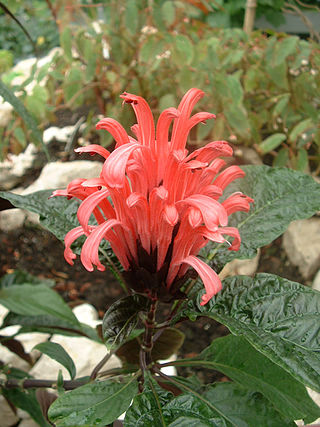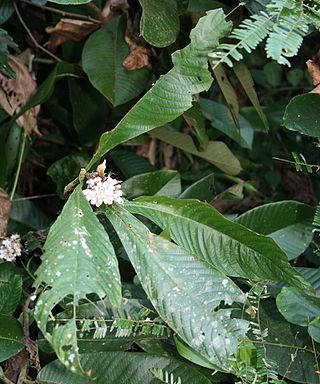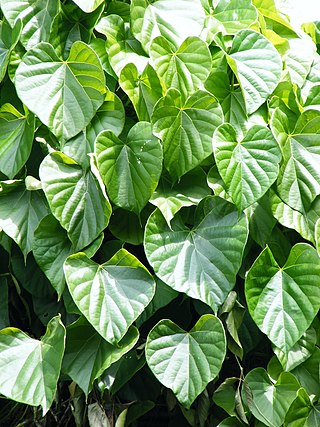
Rubia is the type genus of the Rubiaceae family of flowering plants, which also contains coffea (coffee). It contains around 80 species of perennial scrambling or climbing herbs and subshrubs native to the Old World.

Strobilanthes is a genus of about 350 species of flowering plants in the family Acanthaceae, mostly native to tropical Asia and Madagascar, but with a few species extending north into temperate regions of Asia. Many species are cultivated for their two-lipped, hooded flowers in shades of blue, pink, white and purple. Most are frost-tender and require protection in frost-prone areas. The genus is most famed for its many species which bloom on long cycles of several years, such as Strobilanthes wightii which blooms every thirteen years.

Justicia is a genus of flowering plants in the family Acanthaceae. It is the largest genus within the family, with over 900 accepted species. They are native to tropical to warm temperate regions of the Americas, India, and Africa. The genus serves as host to many butterfly species, such as Anartia fatima. Common names include water-willow and shrimp plant, the latter from the inflorescences, which resemble a shrimp in some species. The generic name honours Scottish horticulturist James Justice (1698–1763). They are closely related to Pachystachys.
Lawrence Johnson is an American pole vaulter, born in Norfolk, Virginia. He earned the nickname "LoJo" at the University of Tennessee where he won four NCAA titles in the pole vault. LoJo began pole vaulting in 1989 and since has/holds records on all stages and led the charge to return the US to the international medal podium with two Olympic appearances, including a silver medal performance in 2000 Olympic games Sydney.

Senna, the sennas, is a large genus of flowering plants in the legume family. This diverse genus is native throughout the tropics, with a small number of species in temperate regions. The number of species is estimated to be from about 260 to 350. The type species for the genus is Senna alexandrina. About 50 species of Senna are known in cultivation.

Lepidagathis is a genus of flowering plants in the family Acanthaceae. It includes 151 species native to the tropics of the Americas, sub-Saharan Africa, south and southeast Asia, southern China, Malesia, and New Guinea.

Gymnostachyum is a genus of flowering plants in the family Acanthaceae. It includes 50 species native to tropical Asia, ranging from the Indian subcontinent through Indochina to southern China, Peninsular Malaysia, Sumatra, Java, and the Philippines.

Pseuderanthemum is a genus of plants in family Acanthaceae with a pantropical distribution.

Eranthemum is a genus of plants in the family Acanthaceae. It includes 23 species native to the Indian subcontinent, Indochina, southern China, Sumatra, and Java.

Mycetia is a genus of flowering plants in the family Rubiaceae. It includes 54 species, ranging from the Indian subcontinent through Indochina, southern China, and Malesia to New Guinea.
Lerchea is a genus of flowering plants in the family Rubiaceae. It was described by Carl Linnaeus in 1771. The genus is found from southern China to western Malesia.
Leptomischus is a genus of plants in the family Rubiaceae, native to southern China and southeast Asia. A 2019 molecular phylogenetic study placed it in the tribe Argostemmateae.
Justicia austroguangxiensis is a species of flowering plant in the family Acanthaceae. It is a perennial native to Guangxi Province of southern China.

Tinospora is a genus of flowering plants. Its species have a succulent, woody, climbing shrub habit. Thirty-four species are currently recognized. Species generally send down long aerial roots from host trees. They have corky or papery bark. They are found in tropical and sub-tropical parts of Asia, Africa and Australia. The most common species are T. cordifolia and T. crispa.
Arcangelisia is a genus of flowering plants belonging to the family Menispermaceae.

Cosmianthemum is a genus of flowering plants belonging to the family Acanthaceae.

Pachygone is a genus of flowering plants belonging to the family Menispermaceae.

Rungia is a genus of flowering plants belonging to the family Acanthaceae.
Rostellularia is a genus of flowering plants belonging to the family Acanthaceae.












